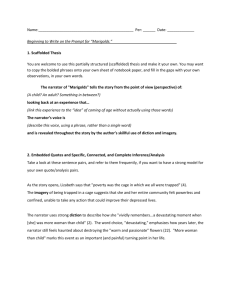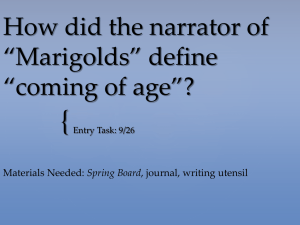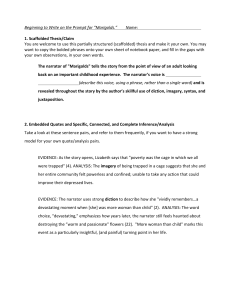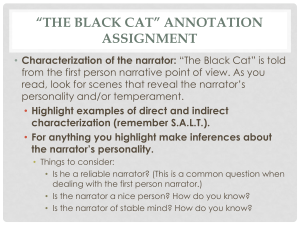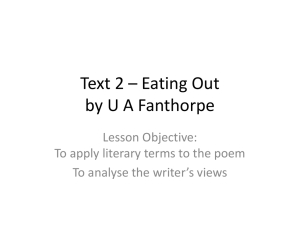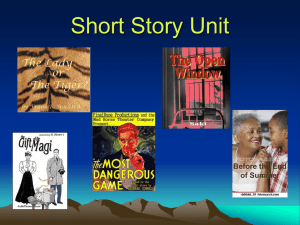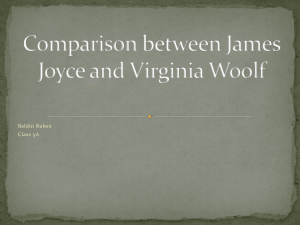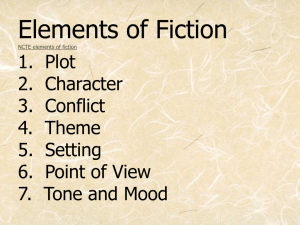1.5 Defining Experiences: Marigolds
advertisement
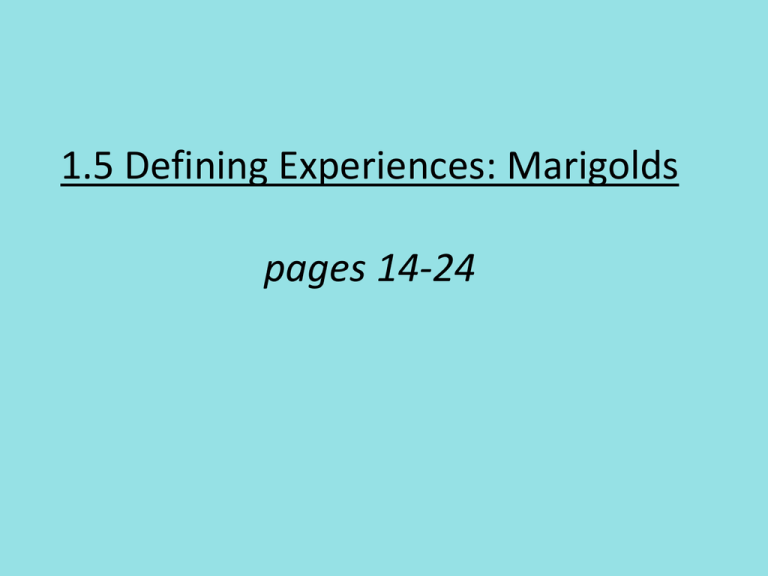
1.5 Defining Experiences: Marigolds pages 14-24 In your spiral… Brainstorm a list of things you might write about if you were asked to write a “coming of age” story. When does the process of “coming of age” start and end? Class Definition of “Coming of Age” Timeline: The Heartbeat of Your Life (12yrs old- 30 yrs old) 1. Brainstorm milestones in addition to those we noted as a class. 2. Place dots for positive milestones above the line with the associated age, dots for negative below the line, and dots for neutral on the line. 3. Connect the dots with straight lines to show the “heartbeat” of your life. Academic Vocabulary: DENOTATION & CONNOTATION Literary Terms: DICTION Connotation & Denotation Connotation is the emotional and imaginative association surrounding a word. Denotation is the precise dictionary meaning of a word. Example: inexpensive : cheap Cars of the 1960s: Thunderbird, Falcon, Charger, Comet, Mustang, Barracuda. Cars of the 1970s: Rabbit, Pinto, Colt, Civic, Starlet, Gremlin. In your table groups: For each list, choose the word that is mostly neutral (the denotation of all the other words) and which is the most positive and negative in terms of connotation List One: Thin, slim, lanky, skinny, gaunt, slender List Two: Aggressive, assertive, domineering, dynamic, pushy, forceful List Three: Bright, clever, brilliant, cunning, smart, intelligent, brainy LEARNING TARGETS 1. Explain how a writer creates effects through the connotations of words and images. 2. Use textual details to support interpretive claims. BEFORE READING Complete prompts 1-4 on Page 14. Be prepared to share your work. About the Author: Eugenia Collier Introduction: A Shared Reading DURING READING . . . As you read, highlight and annotate the text for examples of diction, syntax, and imagery that create the narrator’s voice. Use the “My Notes” (and other margins) to annotate the connotative effect of word choices, and explain the inferences they lead you to make regarding the tone, character, or the significance of the event. Stop reading to respond in writing to “Key Ideas and Details” when you are prompted. Literary Term: FORESHADOWING a literary device in which a writer gives an advance hint of what is to come later in the story Close Reading: Page 18 In Paragraph 22, why are the marigolds so important to Miss Lottie, and why do the children hate them? Close Reading: Page 19 Describe the internal conflict going on in the narrator, Lizabeth. What textual evidence did you find to support your statement? Close Reading: Page 20 Put a box around the entire overheard conversation between the parents. How does this make Lizabeth feel, and what is the consequence of her hearing this conversation? Close Reading: Page 21 Paragraphs 53-58 Highlight the phrases in the text, describing the incident of destruction, that give clues to the reasons for her actions. Literary Term: JUXTAPOSITION the arrangement of two or more things for the purpose of comparison Close Reading: Page 21 Paragraph 60 is especially rich in juxtaposition. What textual examples of this did you find? Close Reading: The Last Sentence Discuss in your groups: Is the narrator speaking literally, metaphorically, or both? Think-Pair-Share What are some ways in which people plant metaphorical marigolds? 1.5 Springboard: Marigolds In Groups 1. Share examples of diction and imagery from your annotations. 2. Work together to complete the Graphic Organizer worksheet (add your names to the worksheet) 3. CYU: Discuss the voice of the narrator and how the use of vivid imagery and diction is effective in conveying this significant incident (see page 24 if needed). Write your group response on the back of the worksheet. Be prepared to share with the class! Revisiting the ESSENTIAL QUESTION page 4 What does it mean to “come of age”? How did the narrator of “Marigolds” define “coming of age”? WORD WALL Check-In After having completed this analysis, do you better understand the concept of VOICE? What can you add to your Word Wall definition? QHT Review your QHT Chart in your Journal. Are there any words you need to move into a different column? + 1.5 “Marigolds” Check Your Understanding Paragraph + Check Your Understanding page 24 Describe the voice of the narrator. Then, explain how the writers dictionand imagery create this voice. You might also mention other literary elements, such as juxtaposition, and syntax (i.e. parallel structure, hyphens, etc.) that contribute to the narrator’s voice or point of view. You paragraph must: Begin with a clear thesis (claim) for your position. Include multiple direct and indirect quotes to support your claim, and punctuate them correctly. Include transitions and a concluding statement. + What is the prompt? The prompt asks to describe the NARRATOR’S voice, not the author’s The author did not have this childhood experience, it is a fictional story, her character, Lizabeth, experiences this event Diction, imagery, syntax & other elements used that fall within one of these categories (parallel structure is an example of syntax) + How to begin (see scaffolded thesis handout) Introduce the title and author and give a little background on the main character NOT A SUMMARY (this is only one sentence) Write a thesis (see scaffolded thesis on worksheet as well) -The narrator, Lizabeth’s ______________ (insert word or phrase)voice is developed through the use of diction and imagery to reflect her _________ (adjective; description of voice) tone. + How to integrate quotes Use manageable quotes, one or two phrases If it is longer than a sentence, then break up the quote into manageable pieces (use ellipses…) Integrate Analyze each quote into your writing different parts of the quote in depth, choose one or two words to analyze at a time + Example of integrating quotes The narrator conveys a reflective voice by using imagery such as “everything was suddenly out of tune, like a broken accordion.” The narrator uses a simile to compare her life to a broken accordion. Her worldview shatters because the problems of her father gives her a glimpse of reality. The narrator’s diction further conveys feelings of confusion and frustration, through words such as “broken” and “bewilderment.” + Tips Further elaborate Analysis, not summary (why), reference “coming of age” moment WITHOUT saying “coming of age” Talk about narrator’s voice How is it conveyed: through imagery and diction, you can also use other literary elements to discuss, figure of speech, figurative language (metaphor, simile, hyperbole, etc.), characterization, dialogue, syntax etc. End with conclusion, restate what the voice is, and how you can tell (uses diction and imagery, etc.)
